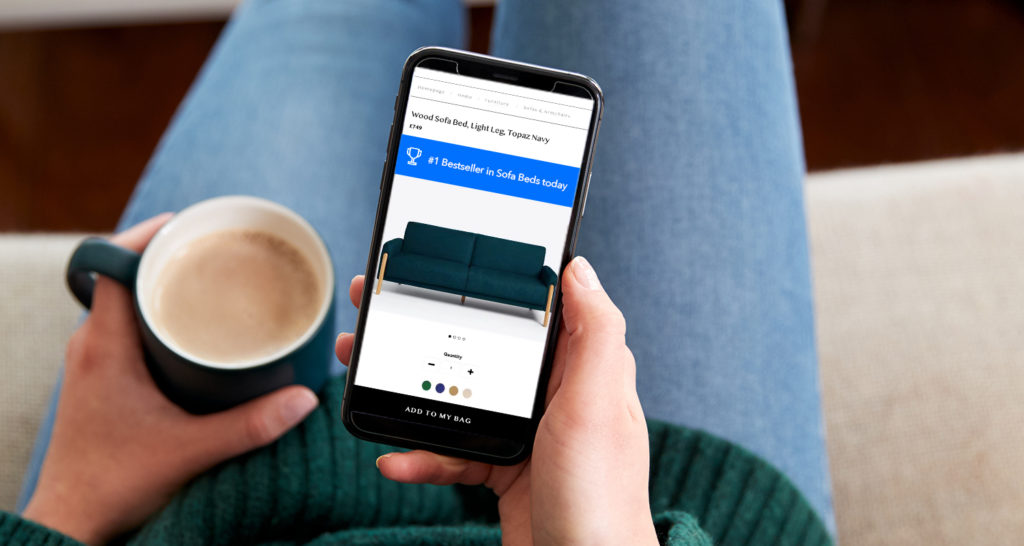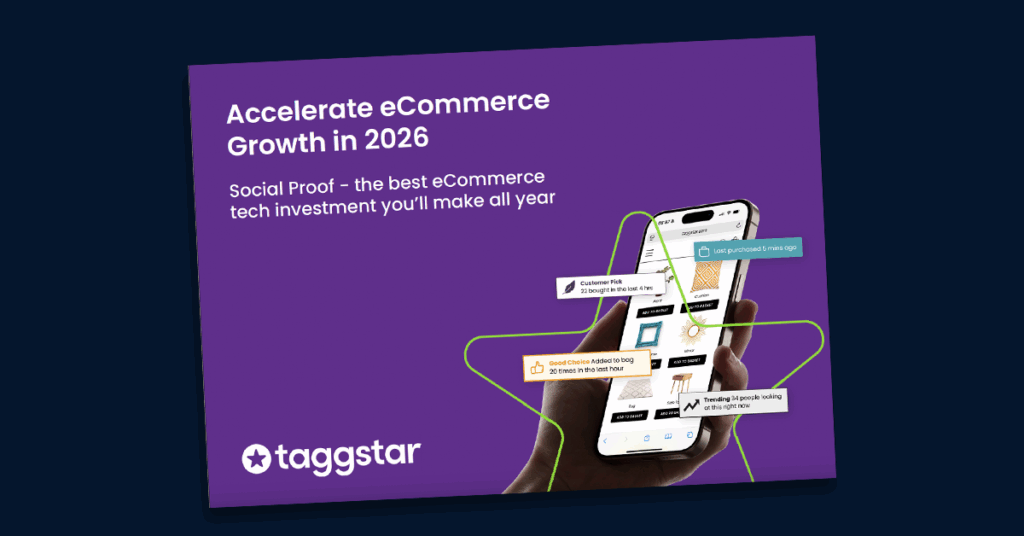What is social proof in marketing?
Social proof in marketing leverages psychological principles to influence consumer decisions based on observed actions of others. It enhances credibility, builds trust, and directly motivates customers towards making purchases. Typical applications include customer reviews, testimonials, influencer endorsements, and behavioral cues that boost sales, engagement, and customer loyalty.
In eCommerce, social proof is extremely important, leading to more engaging customer experiences, higher online conversion rates and reduced returns.
In this article, we delve deeper into why social proof works and how to use it effectively within your marketing mix to boost ROI.
What you’ll learn in this guide:
- The psychology of social proof in marketing
- Benefits of using social proof in your strategy
- How to apply social proof in marketing and eCommerce
- Proven strategies and how Taggstar supports them
- Real-world examples of social proof in action
- Common mistakes to avoid
- How to boost conversions with real-time social proof
- Steps to get started with your own strategy
- What to look for in a social proof solution
- FAQs about social proof in marketing and eCommerce
The psychology of social proof in marketing
The psychology of social proof, first defined by Robert Cialdini, explains our tendency to mirror the actions of others – especially in uncertain situations. In marketing, this principle underpins how brands build trust through customer behavior, expert endorsements, and real-time shopper activity.
Want to learn more? Explore our comprehensive definition of social proof for a deeper dive into the psychology behind it.
Benefits of using social proof in your marketing and eCommerce strategy
Leveraging social proof strategically delivers compelling benefits, directly impacting sales and brand credibility:
- Enhanced Customer Satisfaction: Real customer experiences create genuine brand connections, boosting loyalty and repeat sales.
- Increased Trust & Credibility: Consumers trust brands validated by peers and experts, making them more likely to engage and purchase.
- Higher Conversion Rates: Social proof reduces decision fatigue, driving more confident buying decisions.
- Reduced Product Returns: Authentic feedback and visual proof help align customer expectations with reality.
How to use social proof in marketing and eCommerce
There are several ways to incorporate social proof into your marketing and eCommerce activities to deliver more trustworthy and engaging customer experiences. By leveraging social proof to showcase what other people are buying from a site and highlighting that customers are happy with the products and services sold, most retailers and brands see immediate results, including higher online conversions, more engagement, fewer returns, increased AOV (average order value) and more.
Social proof marketing and eCommerce strategies and how Taggstar helps
To maximize the impact of social proof on your marketing and eCommerce performance, consider these strategic approaches:
- Real-time social proof messages: Display recent purchases, trending products, or live customer activity to create urgency and trust.
- Segmented messaging: Show personalized social proof based on visitor behavior or product categories.
- Cross-channel deployment: Integrate social proof across website, email, social media, display ads, and native apps to reinforce credibility.
- Continuous testing & optimisation: Use A/B testing and AI to identify and deliver the highest-performing messages for each customer segment.
Taggstar’s solution:
Taggstar automates these strategies using real-time customer data. Our AI-powered platform delivers proven conversion uplifts by showcasing the right social proof at the right time. Retailers and brands using Taggstar have reported significant increases in average order value (AOV), conversion rates, and customer engagement.
Social proof in marketing examples
1. The Wisdom of the Crowd
Social proof messaging pools the wisdom of the crowd to help customers with product discovery and to help make informed and confident purchasing decisions.
- Key Tips:
- Social proof messaging should always be based on real-time data – without this, you expose your brand to risk.
- Use simple, factual messages tailored to suit your brand tone of voice
- Ensure you can implement this technology across Product Listing Pages (PLPs), Product Description Pages (PDPs), Checkout Pages, Display Ads, Native App, Emails, Social Media, and Digital OOH
- Deploy A/B testing to rigorously test statistically significant uplifts
- Ensure artificial intelligence (AI) is built in as standard
2. User Generated Content / Shared Content
UGC or Shared Content is often referred to as ‘earned’ content. This may happen naturally, but there are very effective tactics you can employ to maximize UGC for your brand:
- Key Tips:
- Encourage customers to share photos of their recent purchase in return for discounts on their future purchase, prizes for the best content or even simply increased exposure. Using emails and leaflets with the items when delivered, are two easy ways to communicate this whilst encouraging customers to tag you and use your preferred hashtags for maximum exposure
- Reshare their content (with their permission!) on your main channel, ensuring you reciprocate the @. This shows your followers that if they share great content, they may get additional exposure for their own handle
- Share in your stories and link through to the product(s) being shown
EXAMPLE: This example from Steve Madden perfectly showcases how they’ve both encouraged UGC and woven it into their eCommerce site. cases how they’ve both encouraged UGC and woven it into their social media strategy.
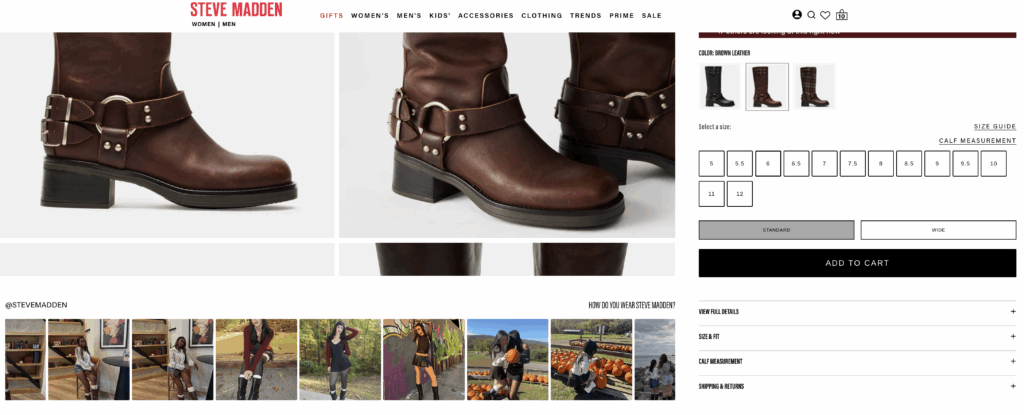
3. Reviews, case studies, customer comments and testimonials
Consumers rely on other consumers to learn about products and often become (often unknowingly) brand advocates through user-generated content (UGC) like customer reviews, photos and Q&A.
- Key Tips
- Go deeper than ‘comments’ alone. Layer this with fit, quality, value, and which size and/or color variant the customer chose
Reviews can be pulled into social proof messaging and deliver even greater ROI uplifts as seen in the example below from Wickes.
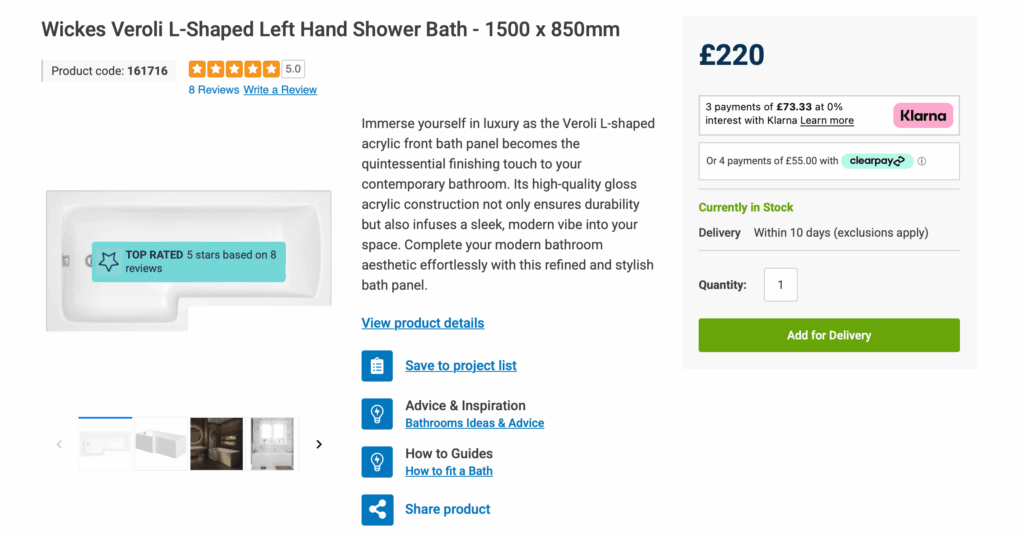
4. Influencer/celebrity endorsements
Influencer marketing has become a fundamental channel for many eCommerce brands. Not only can this help your brand reach new audiences, but it also helps align your brand and its values with those of their followers
- Key Tips:
- The influencer or celebrity’s own style and tone of voice should lead the content, rather than be led by your brand, to retain authenticity
- Developing new product lines in collaboration with influencers will deliver even greater authority
EXAMPLE: Fabletics has a network of influencers that they collaborate with and promote their content across Instagram, Tik Tok, their website and app.
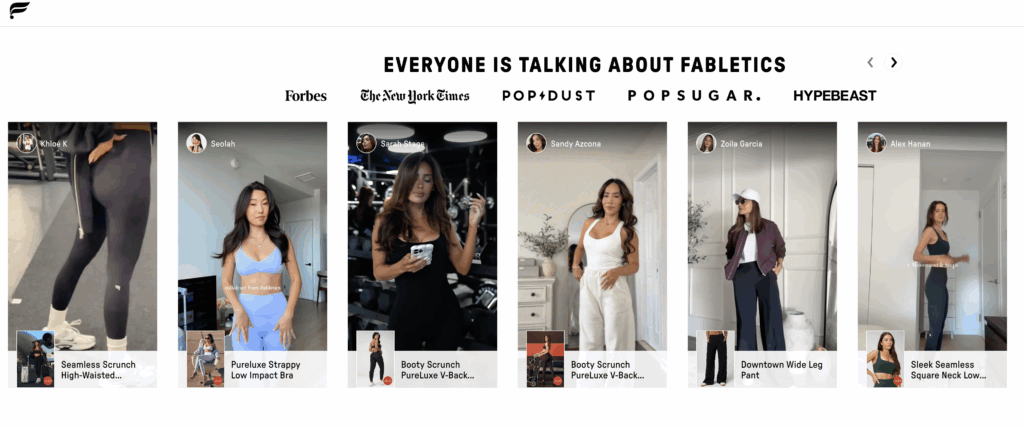
5. Expert opinion, accreditations and third-party endorsements
Independent third-party accreditation provides consumers with a verified ‘stamp of approval’. This can be particularly powerful for items requiring a high investment
- Key Tips:
- Leverage existing partnerships and industry relationships. This could be in the form of awards you may have won, industry standards you’ve achieved and industry body reviews
- On social platforms, this can be as simple as having the verification symbol on your handle
6. Credentials
Almost all companies will have their own credentials that can be used to showcase authority and credibility, such as:
- the number of customers they have
- how many years they’ve been operating
- which countries they operate in
- how many items have been sold
- the number of reviews given
EXAMPLE: This example from Crew Clothing demonstrates this perfectly by aligning the years they’ve been established with timeless British style.

7. Combining social proof techniques
These social proof tactics do not need to be used in isolation. By understanding which will be most important to your customers at each point of the buying journey, they can be combined to great effect.
Common mistakes to avoid in social proof marketing
Avoid common pitfalls to ensure your social proof marketing remains authentic, compelling, and effective:
- Avoid Generic Testimonials: Specific, detailed testimonials resonate better with your audience and improve credibility.
- Never Fake It: Always use real-time data and genuine user experiences; transparency is key to maintaining trust.
- Don’t Overload or Misplace Social Proof: Strategically balance various forms of social proof across your marketing channels.
- Regular Updates are Essential: Continuously refresh your social proof to stay relevant and credible in consumers’ eyes.
Boost conversions and drive sales with Taggstar’s social proof
At Taggstar, our experts have pioneered social proof technology, helping global eCommerce brands implement scalable social proof marketing and eCommerce strategies that deliver measurable results. Our social proof messaging solution integrates these tactics across the digital buying journey to deliver consistent and significant ROI uplifts.
Many leading retailers have already achieved measurable results with Taggstar’s social proof technology:
- Fabletics saw a 3.19% increase in conversions after integrating Taggstar’s social proof messaging across their site.
- Steve Madden reported a 5.41% uplift in conversion rates and stronger customer engagement.
- The Very Group achieved over a 15% improvement in conversion rates, demonstrating how consistent testing and optimization can drive ROI
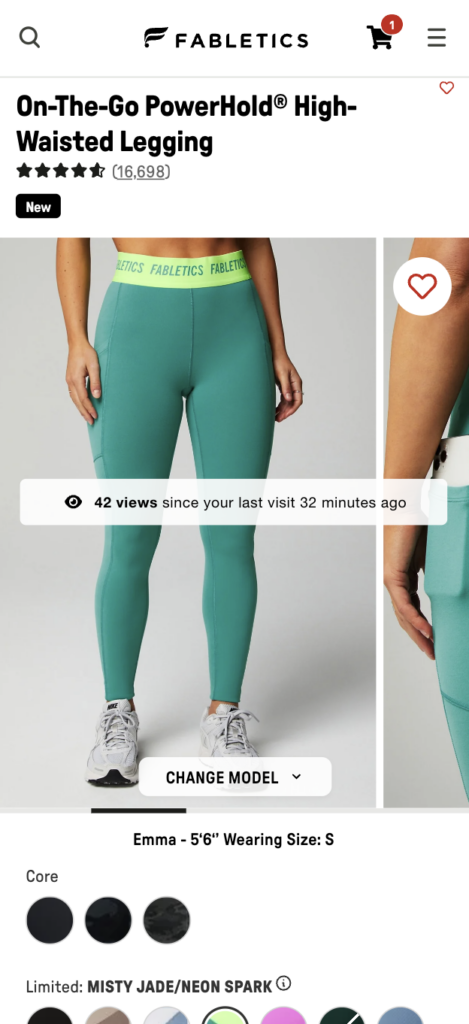
Getting started with social proof in marketing
Social proof can be woven into your eCommerce, digital and overall marketing strategy with almost immediate effect and deliver statistically significant ROI uplifts in a matter of weeks. Taggstar’s social proof solutions can help you take your real-time purchasing behavior to deliver consistent and measurable conversion rate uplifts from day one.
What to look for when selecting social proof messaging solutions for your business
- AI-powered social proof based on real-time data taken directly from the retail/brand’s own systems
- Simple, factual messages tailored to suit your brand tone of voice
- Platform-agnostic implementation that works across any eCommerce platform
- Multiple channel integration (e.g. website, social, display ads, native app, email, OOH)
- A/B testing to rigorously test statistically significant uplifts
- The ability to integrate different types of social proof to increase conversion rates
- The right solution enables brands to turn behavioral data into persuasive, real-time messaging – transforming social proof into a powerful ROI-driven marketing and eCommerce strategy.
FAQs about social proof in marketing and eCommerce
Q1. What is social proof in marketing?
Social proof in marketing is the psychological phenomenon where consumers are influenced by the actions and opinions of others. This includes reviews, testimonials, influencer endorsements, and real-time customer activity. Using social proof strategically can increase trust, conversions, and engagement on your website.
Q2. What is a social proof strategy?
A social proof strategy is a structured approach to integrating credibility signals (like reviews or expert endorsements) across your marketing and eCommerce touchpoints to maximise ROI.
Q3. How can I use social proof in marketing strategy?
Incorporate social proof across multiple channels—your website, emails, social media, display ads, and apps. Test different formats like trending products, reviews, and ratings. Taggstar’s platform helps you deliver these messages strategically to maximize conversions.
Q4. How does social proof impact eCommerce?
Social proof reassures online shoppers, reduces hesitation, and drives higher conversion rates – especially when powered by real-time data from platforms like Taggstar.
Q5. What are examples of social proof in digital marketing?
Examples include testimonials, influencer collaborations, user-generated content, expert endorsements, and real-time notifications that display live shopper activity.
Interested in social proof?
Get in contact today and one our social proof experts will be in touch

